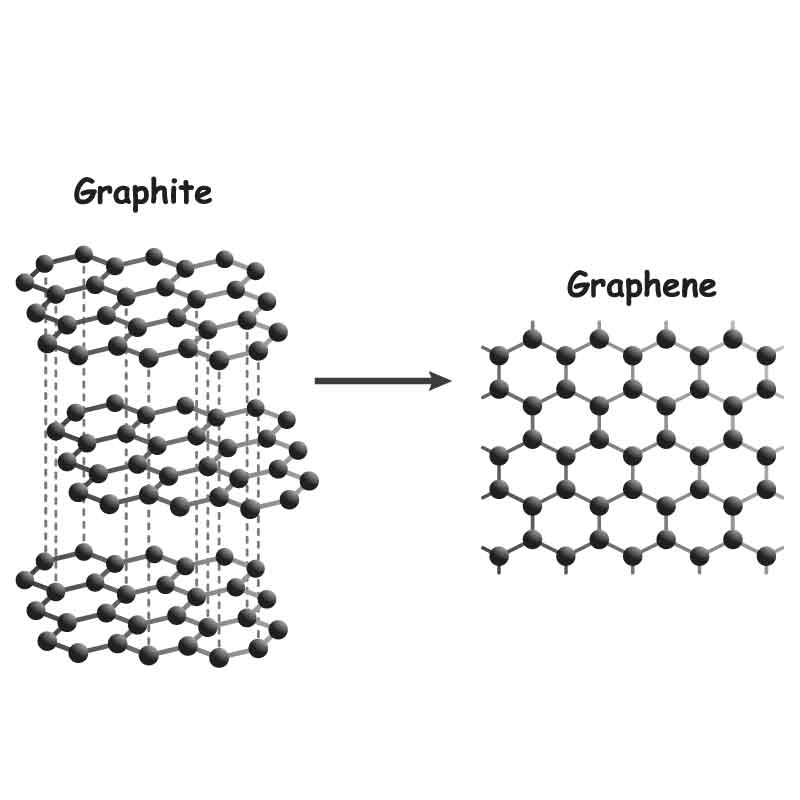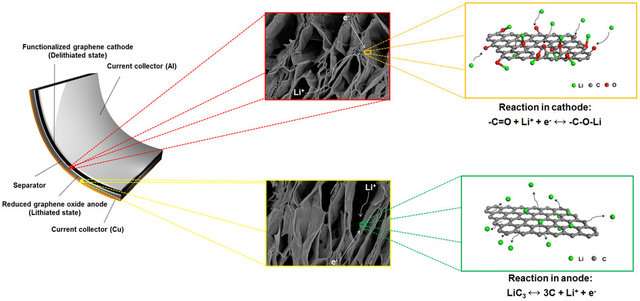Graphene, in new battery tech, provides excellent electrical conductivity compared to Lithium-ion batteries. Better conductivity allows it to charge cells extraordinarily fast, and deliver very high currents. This is especially suitable for automobile batteries and instant device-to-device charging.
In this article we look at the applications for graphene in new technologies, and its advantages and disadvantages over traditional sources of charging.
What is Graphene?
Graphene’s chemical structure is a naturally occurring version of carbon, called graphite. The same mineral we use in our pencils. Its 2D atomic structure is a single layer of carbon atoms on the vertices of regular hexagons. These follow one another on a planar lattice, as illustrated below.

The Benefits of Graphene
The honeycomb lattice pattern of Graphene, is a highly stable structure. Thus, it has wonderful electrical holding properties, far superior to Lithium. It is also very strong, yet lightweight, and very flexible. Its large surface area provides an excellent conductor of thermal energy.
As a result, Graphene is safer to use than many alternatives. Its application would reduce the amount of toxic chemicals in the tech industry, and reduce CO2 emission in the atmosphere. Overall, it promises to be eco-friendly and sustainable, with virtually unlimited capabilities and many potential uses.
Graphene in New Battery Tech
Importantly, Graphene could transform conventional batteries. Graphene in new battery tech stores and charges batteries much more quickly and safely. It also promises longer life than conventional batteries.
However, Graphene-based batteries are not yet commercially viable on a large scale. Research and development is working on ways to bring it to market.
Currently, Lithium sulfur (Li-S) batteries are the most commercially available battery for high-tech applications. The aerospace industry leads the present market in demand for Li-S batteries.
However, new battery tech with graphene appears in a number of applications, namely:
- Unmanned aerial vehicles (UAV)
- Maritime transportation
- Stationary energy storage systems (ESS)

Other Uses for Graphene in New Tech
Interestingly, the chemical composition of Graphene and Diamond is the same. Both are comprised of pure carbon, but have a different chemical structure. The atomic arrangement of graphene is known as allotropy. This is what makes it safer and more stable to use than most other conductors.
Graphene’s strength, conductivity and lightness offer huge advantages. A one-square-meter sheet of graphene weighs about 0.77 mg. It is 200 times as tough as steel, with a density equivalent to carbon fibre.
Thus, it is often referred to as a wonder material. In fact, there are already many applications for graphene, in areas like building and construction, medicine, the food industry and high tech electronics. Notably, there are also uses for graphene in renewables, including the manufacture of solar cells, nuclear power plants, large scale batteries, and water filters.
Currently, graphene is driving developments in:
- Medicine
- Agriculture
- Aerospace and Aviation
- Waterproofing
- Sensors
- Membranes and filters
- Energy Storage
- Machinery (including lubrication)
Will Graphene Replace Conventional Battery Tech Soon?
Graphene battery technology is similar to conventional batteries. They both contain two electrodes and an electrolyte solution to support the transfer of ion. However, the amount of graphene in the ‘composite‘ can vary, depending on the intended application.

Graphene aluminum-ion battery cells can charge 60 times faster than lithium-ion cells, and they hold a great deal more energy.
Graphene sodium-ion and graphene aluminum-ion batteries are also cheaper and easier to recycle than lithium-ion batteries. Furthermore, sodium and aluminum are far more abundant in nature than lithium.

EV Batteries
- Tesla recently announced that the Model 3 EV battery has an energy density close to 260 Wh/kg. However, it is still experiencing problems with overheating. Graphene batteries offer high thermal conductivity, so they do not overheat or explode. As a result, there is no need for a battery cooling system which would free up more space for storage.
- GAC Motor Co. Ltd, a Chinese automobile company, announced the launch of the AION V car, which features a graphene battery with a range of 1000 km. The battery can be recharged to 80 percent capacity in 8 minutes.
So, the commercial manufacture of graphene batteries may not be all that far off. However, without mass production, cost is a major limitation. Also, the thinness of graphene as a material hinders overall storage capacity. Moreover, graphene batteries currently display very poor retention of capacity, sometimes losing up to 50-60% of capacity after only one cycle.
The Disadvantages of Graphene
So, graphene has some major limitations right now. There are a number of challenges to address, including:
- The high cost and complexity of production
- Its susceptibility to an oxidative atmosphere
- Some toxicity and poisonous qualities
- An increased the possibility of defects
- It does not easily stretch
- At lower sizes, such as 20nm, it is unstable
The Thrive Framework
At THRIVE we believe that there is no truly sustainable energy system in an unsustainable world. The Thrive Framework has been developed to assess the impact of alternative strategies towards sustainability.
At its core, sustainability simply means the ability to continue, to survive. ‘Thrivability‘, by contrast, is the next step, beyond sustainability. THRIVE believes that humanity can do better with the knowledge currently available to us. We want to instil the idea that sustainable solutions will not only prevent climate disaster but offer the potential for societies to flourish.
The THRIVE Framework examines issues and evaluates potential solutions in relation to this overarching goal of thrivability. It is about making predictive analyses using modern technology that support environmental and social sustainability transformations.
To learn more about how The THRIVE Project is researching, educating and advocating for a future beyond sustainability, visit our website. However, you can follow our informative blog and podcast series, as well as find out about our regular live webinars featuring expert guests in the field. Sign up to our newsletter for regular updates.
GOT A QUESTION ON THIS TOPIC?